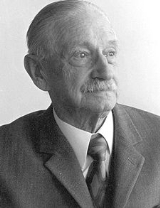
Walther Meißner
Encyclopedia
Fritz Walther Meißner (December 16, 1882, Berlin
– November 16, 1974, Munich
) was a German technical physicist.
Meissner was born in Berlin
to Waldemar Meissner and Johanna Greger. He studied mechanical engineering and physics at the Technical University of Berlin
, his doctoral supervisor being Max Planck
. He then entered the Physikalisch-Technische Bundesanstalt
in Berlin. From 1922 to 1925, he established the world's third largest helium-liquifier, and discovered in 1933 the Meissner effect
, damping of the magnetic field
in superconductors. One year later, he was called as chair in technical physics at the Technical University of Munich
.
After World War II
, he became the president of the Bavarian Academy of Sciences and Humanities
. In 1946, he was appointed director of the academy's first low temperature research commission. Laboratories were located in Herrsching am Ammersee
until 1965, when they were moved to Garching. Meißner lived alone with his two dogs for the last several years of his life. Meißner died in Munich in 1974.
Berlin
Berlin is the capital city of Germany and is one of the 16 states of Germany. With a population of 3.45 million people, Berlin is Germany's largest city. It is the second most populous city proper and the seventh most populous urban area in the European Union...
– November 16, 1974, Munich
Munich
Munich The city's motto is "" . Before 2006, it was "Weltstadt mit Herz" . Its native name, , is derived from the Old High German Munichen, meaning "by the monks' place". The city's name derives from the monks of the Benedictine order who founded the city; hence the monk depicted on the city's coat...
) was a German technical physicist.
Meissner was born in Berlin
Berlin
Berlin is the capital city of Germany and is one of the 16 states of Germany. With a population of 3.45 million people, Berlin is Germany's largest city. It is the second most populous city proper and the seventh most populous urban area in the European Union...
to Waldemar Meissner and Johanna Greger. He studied mechanical engineering and physics at the Technical University of Berlin
Technical University of Berlin
The Technische Universität Berlin is a research university located in Berlin, Germany. Translating the name into English is discouraged by the university, however paraphrasing as Berlin Institute of Technology is recommended by the university if necessary .The TU Berlin was founded...
, his doctoral supervisor being Max Planck
Max Planck
Max Karl Ernst Ludwig Planck, ForMemRS, was a German physicist who actualized the quantum physics, initiating a revolution in natural science and philosophy. He is regarded as the founder of the quantum theory, for which he received the Nobel Prize in Physics in 1918.-Life and career:Planck came...
. He then entered the Physikalisch-Technische Bundesanstalt
Physikalisch-Technische Bundesanstalt
The Physikalisch-Technische Bundesanstalt is based in Braunschweig and Berlin. It is the national institute for natural and engineering sciences and the highest technical authority for metrology and physical safety engineering in Germany....
in Berlin. From 1922 to 1925, he established the world's third largest helium-liquifier, and discovered in 1933 the Meissner effect
Meissner effect
The Meissner effect is the expulsion of a magnetic field from a superconductor during its transition to the superconducting state. The German physicists Walther Meissner and Robert Ochsenfeld discovered the phenomenon in 1933 by measuring the magnetic field distribution outside superconducting tin...
, damping of the magnetic field
Magnetic field
A magnetic field is a mathematical description of the magnetic influence of electric currents and magnetic materials. The magnetic field at any given point is specified by both a direction and a magnitude ; as such it is a vector field.Technically, a magnetic field is a pseudo vector;...
in superconductors. One year later, he was called as chair in technical physics at the Technical University of Munich
Technical University of Munich
The Technische Universität München is a research university with campuses in Munich, Garching, and Weihenstephan...
.
After World War II
World War II
World War II, or the Second World War , was a global conflict lasting from 1939 to 1945, involving most of the world's nations—including all of the great powers—eventually forming two opposing military alliances: the Allies and the Axis...
, he became the president of the Bavarian Academy of Sciences and Humanities
Bavarian Academy of Sciences and Humanities
The Bavarian Academy of Sciences and Humanities is an independent public institution, located in Munich. It appoints scholars whose research has contributed considerably to the increase of knowledge within their subject...
. In 1946, he was appointed director of the academy's first low temperature research commission. Laboratories were located in Herrsching am Ammersee
Herrsching
Herrsching am Ammersee is a municipality in Upper Bavaria, Germany, on the east shore of the Ammersee, southwest of Munich. Population is some 8,000 in winter, increasing to 13,000 in summer....
until 1965, when they were moved to Garching. Meißner lived alone with his two dogs for the last several years of his life. Meißner died in Munich in 1974.

